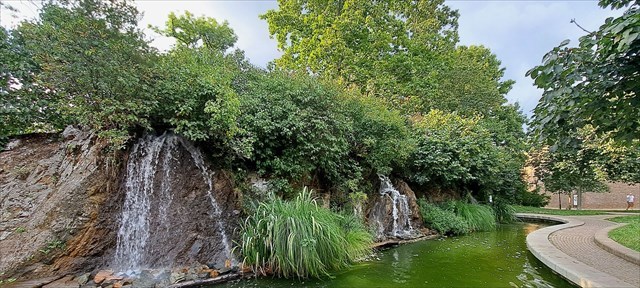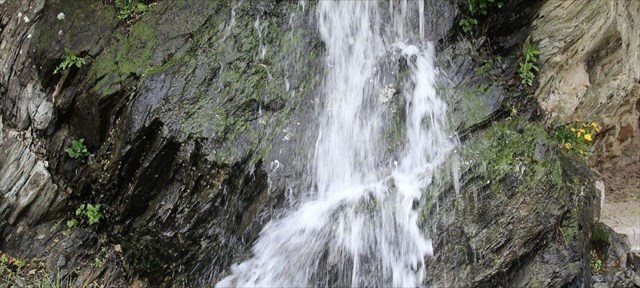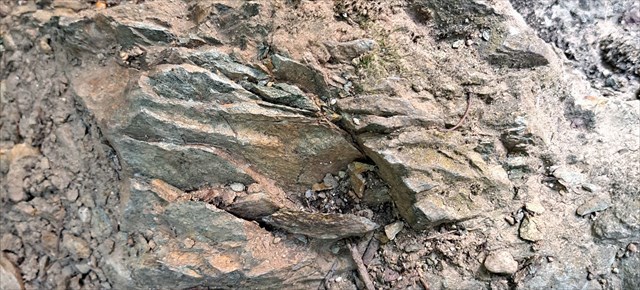|

 Skalní výchozy tvořené vyvřelými metabazalty a usazenými břidlicemi v samotném srdci Brna. Vítejte u mé další EarthCache. Skalní výchozy tvořené vyvřelými metabazalty a usazenými břidlicemi v samotném srdci Brna. Vítejte u mé další EarthCache.
 A rock outcrops formed by igneous metabasalts and sedimentary slates in the very heart of Brno. Welcome to my next EarthCache. A rock outcrops formed by igneous metabasalts and sedimentary slates in the very heart of Brno. Welcome to my next EarthCache.

Vodopády na Špilberku / Špilberk Waterfalls
 Jezírko oválného tvaru se nachází pod výraznou skalkou poblíž jihozápadního bastionu v horní části parku. Na relativně malém prostoru se střídají vulkanické horniny kyselého a bazického složení (metaryolity a již zmíněné metabazalty) doplněné břidlicí na pravé straně výchozu (waypoint Břidlice). Jezírko oválného tvaru se nachází pod výraznou skalkou poblíž jihozápadního bastionu v horní části parku. Na relativně malém prostoru se střídají vulkanické horniny kyselého a bazického složení (metaryolity a již zmíněné metabazalty) doplněné břidlicí na pravé straně výchozu (waypoint Břidlice).
Drobné výchozy tmavých metabazaltů, které se na Špilberku vyskytují, jsou často zakomponované do hradních zdí a hradeb, lze je vidět i v hradním příkopu. Základní hmota se skládá z křemene, kyselého plagioklasu a draselného živce. Někdy se také objevují izolované lupínky chloritu, minerálů epidotové skupiny a kalcitu. Na severní straně výchozu dominuje deformovaná asi 1,5 m mocná břidlice a na jižním okraji výchozu je pozorovatelná několik cm silná a cca 1 m dlouhá křemenná žíla. Břidlice obsahuje kyselé plagioklasy, které jsou často křehce deformovány a rozlámány.
Brno leží na hranici dvou velkých, celoevropsky významných geologických jednotek: starší, prvohorní Český masiv, složený z vyvřelých a přeměněných hornin, a mladší, třetihorní Západní Karpaty, kde převládají horniny usazené.  In the upper part of the park, beneath a prominent rock formation near the southwest bastion, you will find an oval-shaped pond. In this limited area, various types of volcanic rocks alternate, both acidic and basic in composition (metarhyolites and the aforementioned metabasalts). These rocks are complemented by shale located on the right side of the outcrop (waypoint "Břidlice"). In the upper part of the park, beneath a prominent rock formation near the southwest bastion, you will find an oval-shaped pond. In this limited area, various types of volcanic rocks alternate, both acidic and basic in composition (metarhyolites and the aforementioned metabasalts). These rocks are complemented by shale located on the right side of the outcrop (waypoint "Břidlice").
On Špilberk, one often encounters small outcrops of dark metabasalts that have been incorporated into the castle walls and fortifications. These outcrops can also be seen in the castle moat. The basic composition of these rocks includes quartz, acidic plagioclase, and potassium feldspar. Occasionally, isolated particles of chlorite, minerals from the epidote group, and calcite are found in these rocks. On the northern side of the outcrop, a deformed layer of shale, approximately 1.5 meters thick, predominates, while on the southern edge of the outcrop, there is an observable quartz vein, a few centimeters thick and about 1 meter long. The shale contains acidic plagioclases that are often susceptible to deformation and fracturing. Brno lies on the border of two large, pan-European significant geological units: the older, Primordial Bohemian Massif, composed of igneous and metamorphosed rocks, and the younger, Tertiary Western Carpathians, where sedimentary rocks predominate.

Metabazalty / Metabasalts
 Metabazalty jsou typem metamorfovaných hornin, které vznikají transformací bazaltů, což jsou původně magmatické horniny. Během procesu metamorfózy se bazalty pod vlivem tepla a tlaku přeměňují na metabazalty. Název "meta" znamená, že se jedná o horniny, které prošly metamorfózou, což je proces, při němž dochází k fyzikálním a chemickým změnám v horninách bez tání. Metabazalty jsou typem metamorfovaných hornin, které vznikají transformací bazaltů, což jsou původně magmatické horniny. Během procesu metamorfózy se bazalty pod vlivem tepla a tlaku přeměňují na metabazalty. Název "meta" znamená, že se jedná o horniny, které prošly metamorfózou, což je proces, při němž dochází k fyzikálním a chemickým změnám v horninách bez tání.
Jedná se obvykle o tmavé horniny s různými odstíny černé, šedé a zelené barvy. Jejich hlavními minerály jsou pyroxeny (jako augit nebo hornblenda) a plagioklasy (které jsou často modifikované a obsahují živce). Tyto horniny mohou obsahovat také minerály jako chlorit, epidot a amfiboly.
V Česku se vyskytují v pásu mezi Klatovy a Kladnem (kladensko-klatovské spilitové pásmo, např. lom Odolena Voda – Čenkov), v okolí Příbrami a Blovic, řazeny jsou do svrchního proterozoika. Metabasalts are a type of metamorphic rocks that form through the transformation of basalts, which are originally igneous rocks. During the process of metamorphism, basalts undergo changes in response to heat and pressure, resulting in the formation of metabasalts. The term "meta" indicates that these rocks have undergone metamorphism, which is a process involving physical and chemical changes in rocks without melting. Metabasalts are a type of metamorphic rocks that form through the transformation of basalts, which are originally igneous rocks. During the process of metamorphism, basalts undergo changes in response to heat and pressure, resulting in the formation of metabasalts. The term "meta" indicates that these rocks have undergone metamorphism, which is a process involving physical and chemical changes in rocks without melting.
Metabasalts are typically dark rocks with various shades of black, gray, and green. Their primary minerals include pyroxenes (such as augite or hornblende) and plagioclases (which are often modified and contain feldspars). These rocks can also contain minerals like chlorite, epidote, and amphiboles. In the Czech Republic, they are found in the belt between Klatovy and Kladno (the Kladno-Klatov spilite zone, e.g. the Odolena Voda – Čenkov quarry), in the vicinity of Příbram and Blovice, and belong to the Upper Proterozoic.

Usazené břidlice / Sedimentary Slates
 Břidlice je metamorfovaná hornina, která vzniká z jílových a jíloštěrkových hornin, které prošly procesem metamorfózy. Metamorfóza je geologický proces, během kterého dochází k přeměně hornin pod vlivem vysokého tlaku, tepla a času, aniž by došlo k tání. Břidlice je metamorfovaná hornina, která vzniká z jílových a jíloštěrkových hornin, které prošly procesem metamorfózy. Metamorfóza je geologický proces, během kterého dochází k přeměně hornin pod vlivem vysokého tlaku, tepla a času, aniž by došlo k tání.
Břidlice se vyznačuje charakteristickým štěrbinovým a šupinovým zlomem. Jeho struktura je často vrstevnatá, což je důsledek původních vrstev jílových nebo jíloštěrkových hornin. Výsledná hornina je tedy tvořena vrstvami tenkých šupin nebo desek, které mohou být odděleny mezi sebou. Břidlice může obsahovat různé minerály, jako jsou slída, křemenec, chlorit a různé formy živce. Je také známa svou odolností vůči erozi a trvanlivostí, což ji činí užitečným materiálem pro stavebnictví a kamenické práce.
 Slate is a metamorphic rock that forms from clayey and mudstone rocks that have undergone a process of metamorphism. Metamorphism is a geological process where rocks are transformed under the influence of high pressure, heat, and time without melting. Slate is a metamorphic rock that forms from clayey and mudstone rocks that have undergone a process of metamorphism. Metamorphism is a geological process where rocks are transformed under the influence of high pressure, heat, and time without melting.
Slate is characterized by its distinctive fissile and scaly fracture. Its structure is often layered, a result of the original layers of clayey or mudstone rocks. As a result, the resulting rock consists of layers of thin flakes or slabs that can be easily separated from each other.
It contains various minerals such as slate, quartz, chlorite, and various forms of feldspar. It is also known for its resistance to erosion and durability, making it a useful material for construction and masonry work.
 Pro zalogování jako "found it" mi musíte na email přes profil poslat odpovědi na následující otázky a úkoly: Pro zalogování jako "found it" mi musíte na email přes profil poslat odpovědi na následující otázky a úkoly:
1) Obě dvě místní horniny vznikly vlivem jednoho procesu. O jaký proces se jedná?
2) Na úvodkách můžete pozorovat bílou křemennou žílu. Jaká je její tloušťka?
3) Určete, která z hornin (metabazalt na úvodkách a břidlice na waypointu) má větší tvrdost. Čím myslíte, že to je?
4) Do logu nahrajte fotku sebe, nebo vaší GPS s vodopády na úvodkách.  For log as "found it" please send me answers for those questions via my profile: For log as "found it" please send me answers for those questions via my profile:
1) Both local rocks were formed by the same process. What is the name of it?
2) You can observe white quartz vein on the initial coordinates. How thick it is? (in cm)
3) Determine which of the rocks (metabazalt on initial coords and slate on the waypoint) is more harder. Why do you think that is?
4) Take a picture of you or your GPS with the waterfalls on coordinates and upload the picture to the the log.
 Logujte ihned po odeslání odpovědí, pokud bude něco špatně, ozvu se. Logujte ihned po odeslání odpovědí, pokud bude něco špatně, ozvu se.
 Please email your answers through my profile and log this EarthCache. If there's a problem with your answers, I'll get in touch to solve it.. Please email your answers through my profile and log this EarthCache. If there's a problem with your answers, I'll get in touch to solve it..

|